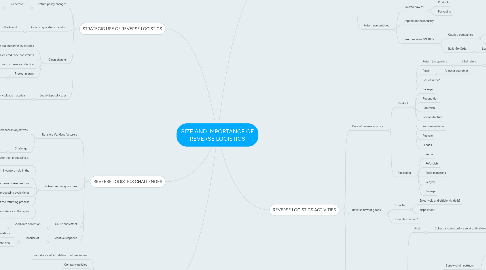
1. STRATEGIC USE OF REVERSE LOGISTICS
1.1. Reverse logistic as a strategic weapon
1.1.1. Strategic variables
1.1.1.1. Long term bottom line impact
1.1.1.2. Viability of the firm
1.1.2. Increases switching costs of changing of supplier
1.2. Competitive reasons
1.2.1. Satisfied customer
1.2.1.1. Most important asset
1.2.1.2. Improve their policies
1.3. Return policy changes
1.3.1. Generous
1.3.1.1. Improved risk sharing
1.3.1.1.1. Sellers
1.3.1.1.2. Consumers
1.4. Good corporate citizenship
1.4.1. Enhance the value of the brand
1.4.1.1. Nike
1.4.1.2. Kenneth Cole
1.4.1.3. Hanna Anderson
1.5. Clean channel
1.5.1. Clean out customer inventories
1.5.2. Reduce credit line constraints
1.5.3. Improve customer satisfaction
1.5.4. Protect margin
1.5.4.1. Fresher inventories
1.5.4.1.1. Better margins
1.6. Legal disposal issues
1.6.1. Non-salvage materials
1.6.1.1. Difficult
1.6.1.1.1. Warning
2. REVERSE LOGISTICS CHALLENGES
2.1. Retailers Vs. Manufacturers
2.1.1. Differences in objectives
2.1.1.1. Conditions of the item
2.1.1.2. Value of the item
2.1.1.3. Timeliness response
2.1.2. Challenge
2.1.2.1. Lack of information about the process
2.2. Problem return symptoms
2.2.1. Returns arriving faster than processing or disposal
2.2.2. Large amount of return inventory held in the warehouse
2.2.3. Unidentified or unauthorized returns
2.2.4. Lengthy processing cycle times
2.2.5. Unknown total costs of the returning process
2.2.6. Customers have lost confidence in the repair activity
2.3. Cause and effect
2.3.1. Good data collection
2.3.1.1. Good manage of inventory
2.4. Reactive response
2.4.1. Because of
2.4.1.1. Government regulations
2.4.1.2. Pressure from environmental agencies
3. BARRIERS TO GOOD REVERSE LOGISTICS
3.1. Importance of RL relative to others issues
3.2. Company policies
3.3. Lack of systems
3.4. Competitive issues
3.5. Management inattention
3.6. Financial ressources
3.7. Personnel resourses
3.8. Legal issues
4. IMPORTANCE OF REVERSE LOGISTICS
4.1. What is reverse logistics?
4.1.1. Moving goods from their typical final destination for the purpose of capturing value or proper disposal
4.1.2. Processing returned merchandise
4.1.2.1. Damage
4.1.2.2. Seasonal/excess inventory
4.1.2.3. Restock
4.1.2.4. Salvage
4.1.2.5. Recalls
4.1.2.6. Obsolet equipment
4.1.2.7. Asset recovery
4.2. Interest in reverse logistics
4.2.1. Is increasing
4.2.1.1. Benchmarking operations with best in classs
4.3. Return percentages
4.3.1. Reverse flow of
4.3.1.1. Products
4.3.1.2. Packaging
4.3.2. Depend on the industry
4.3.3. Direct retailers VS. BTO
4.3.3.1. Catalog companies
4.3.3.1.1. Higher return that most other retail channels
4.3.3.1.2. Reverse logistics strategically
4.3.3.2. Build-To-Order
4.3.3.2.1. Lower rates of return
5. REVERSE LOGISTICS ACTIVITIES
5.1. Core of reverse logistics
5.1.1. Product
5.1.1.1. Return to suppliers
5.1.1.1.1. If full refund
5.1.1.2. Resell
5.1.1.2.1. Another customer
5.1.1.3. Sell via outlet
5.1.1.4. Salvage
5.1.1.5. Recondition
5.1.1.6. Refurbish
5.1.1.7. Remanufacture
5.1.1.8. Reclaim materias
5.1.1.9. Recycle
5.1.1.10. Landfill
5.1.2. Packaging
5.1.2.1. Reuse
5.1.2.2. Refurbish
5.1.2.3. Reclaim material
5.1.2.4. Recycle
5.1.2.5. Salvage
5.2. Reverse flow of goods
5.2.1. How to
5.2.1.1. Effectively and efficiently do it?
5.2.1.2. disposition?
5.2.2. Final destination?
5.3. Classifying reverse logistics activities
5.3.1. First
5.3.1.1. Collect and sort before send to final destination
5.3.2. Coming from
5.3.2.1. Supply chain partners
5.3.2.1.1. Product
5.3.2.1.2. Packaging
5.3.2.2. End users
5.3.2.2.1. Product
5.3.2.2.2. Packaging

